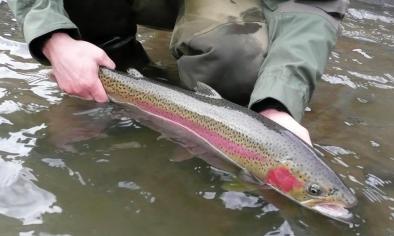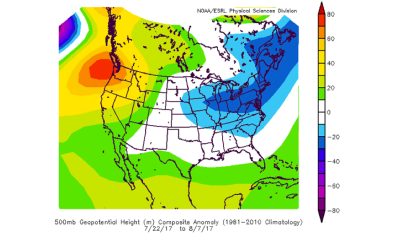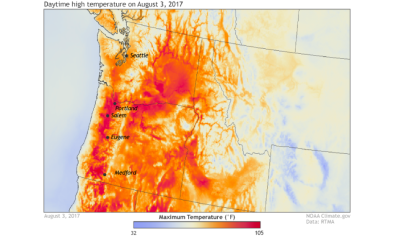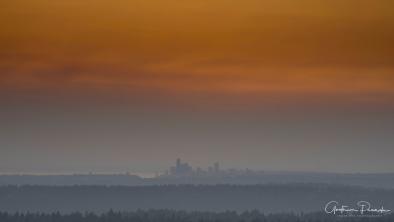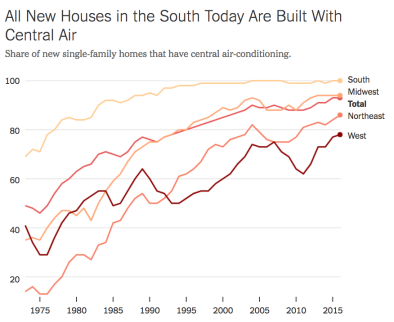Northwest US Heat Wave August 2017
During the first three days of August 2017, some locations in the Pacific Northwest approached their hottest temperatures ever recorded.[1] Much of the Pacific Northwest sweltered in a prolonged heat wave beginning in late July. The heat set some all-time heat wave longevity records in a few locations.[2] The heat was caused by a high pressure system in the atmosphere, which helped keep skies free from clouds and allowed the sun’s energy to heat the surface.
Record breaking heat waves are a classic signal of climate change. The trend in global warming has contributed to the severity and probability of 82 percent of record-hot days globally over the 1961-2010 period.[3]
The kind of stalled weather pattern that intensified the northwestern heat wave is the sort of pattern expected due to climate change.[4]
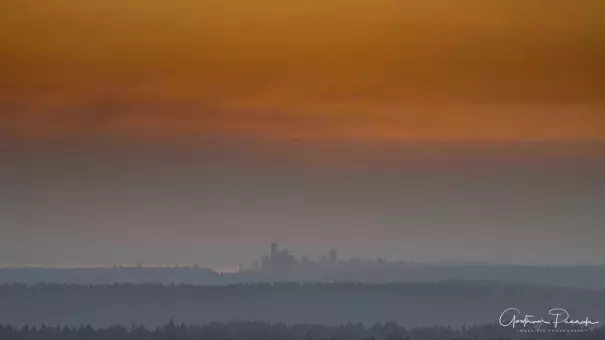
Climate science at a glance
- In the US, western regions set the most records for the number of heat wave events in the 2000s. Heat waves have become generally more frequent across the US in recent decades.[1]
- There has also been a dramatic increase in nighttime temperatures in the US, reducing the number of critically important relief windows during heat waves.[2][3]
- The kind of stalled weather pattern that intensified the northwestern heat wave is the sort of pattern expected due to climate change.[4]
Northwestern states endured record-breaking heat
Three cities in Oregon approached — but did not quite surpass — their all-time record high temperatures: Medford, with 112°F on August 2rd; Salem, with 107°F on August 2nd; and Portland, with 105°F on August 3rd.[5] Temperatures in Portland have risen beyond 105°F only five times in the city’s history.[5]
Portland set a new daily record high of 103°F on August 2nd.[6] Further north on the same day, Seattle logged a new daily record high of 91°F[6] and another on August 3rd (94°F).[5] The previous record high for August 3rd was set in 1939 (91°F).[5] August 2nd also brought the city’s second-warmest low temperature ever recorded: 69°F.[6]
Concerns about heat-related illnesses are compounded by the fact that many residences in Washington, Oregon and California don't have air conditioning — though the proportion of households with air conditioning has doubled since 1990, from one-third to two-thirds.[7] In Portland specifically, about 70 percent of residents have it, whereas in Seattle, only one-third of the population does.[8]
The National Weather Service said on July 31 that coastal Washington, Oregon and Northern California should expect "the hottest and longest period of very hot weather in some years."
Record setting heat waves are a clear signal of climate change
According to the US National Academies of Science, the increasing frequency, intensity, and duration of heat waves is the most firmly established impact of climate change to date.[1]
The northern hemisphere has had increasingly warmer and more humid summers, and the global area covered by extreme water vapor is increasing significantly.[9] Increasing humidity is contributing to higher nighttime temperatures in the US.[10]
Climate change links to stalling weather systems
A study from March 2017 found that climate change is altering large-scale weather patterns, such as the jet stream.[4] These changes can dramatically amplify extreme weather events, such as extreme heat waves, during the summer.[4]
A parallel study has tentatively documented a general slowdown of atmospheric summer circulation in the mid-latitudes.[11] This is a consequence of the disproportionally strong warming in the Arctic. This warming can make weather systems move less and stay longer in a given location – which can significantly enhance the impacts of heat extremes.

